Reduction in Edge-Ringing in Aberrated Images of Coherent Edge Objects by Multishaded Aperture
Abstract
The images of a straight edge in coherent illumination produced by an optical system with circular aperture and apodized with multiple filters have been studied. The most common problem encountered in the coherent-imaging techniques is the edge-ringing. To minimize the edge-ringing, multishaded aperture method has been proposed. Image intensity distribution curves are drawn and edge-ringing values are evaluated. The results are compared to that of the airy case with the use of single, double and triple filtering.
1. Introduction
In order to improve the results of an optical system, there are two methods, namely, modification of the optical system and postdetection processing. The former involves choosing an optimum optical system itself and the latter involves operations on the system’s output. In many situations the first one is followed by changing the pupil function with suitable apodization. Apodization is the technique that modifies the imaging properties of an optical system such that the system impulse does not show ringing by manipulating its entrance pupil [1–3]. Parthasaradhi et al. [4] have investigated the effect of variable apodization on the diffracted field characteristics of aperture with Straubel class of pupil functions and Triangular filters. In their study, they have divided the pupil into different number of concentric annular zones and used the same set of pupil functions having different values of the apodization parameter, thus giving rise to nonuniform transmission of different zones. Ramanathan et al. [5] have investigated the coherent images of straight edges employing variable apodisation with Kaiser filters. Rao et al. [6] have studied the coherent edge imaging of straight edge objects with Straubel apodization filters. Gupta and Singh [7] have studied the frequency response of an apodized system by dividing the aperture into several rings of different areas and also investigated the performance of an optical system having linear polarization masks at different zones on the aperture with a particular reference to the two-point resolution of points having nearly equal brightness and the optical transfer function.
In the previous paper we proposed the technique of “variable apodization” which involves the shading of circular aperture with two or more filters over different zones of the aperture. The present work introduces the technique “multishaded aperture.” This involves the shading of entire aperture with two or more filters simultaneously as shown in Figure 1.
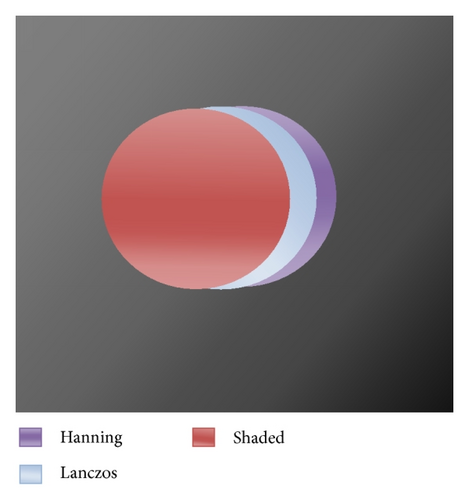
2. Theory
The corresponding intensity distribution of an edge image formed by an apodized optical system is given by the squared modulus of expression (4).
3. Results and Discussions
3.1. Single Pupil Transmission
For the shaded aperture, as given in expression (1), the amplitude transmittance decreases monotonically from the center towards the edges of the pupil. Figure 2 shows this phenomenon in greater detail. Higher spatial frequency components of the object are diffracted by a larger angle and hence these go predominantly through the edge of the aperture. As the pupil transmittance is decreased at the edges as compared to that of the center, due to apodization, the result is reduction in the higher spatial frequency components in the image. This manifests as partial or full suppression of the undesired optical side lobes or secondary maxima, which consequently enhances image features.
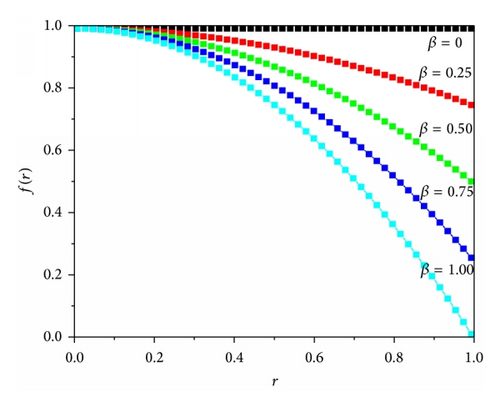
3.2. Double Pupil Transmission
Figure 3 illustrates the response of the amplitude transmittance f(r) for double filter, represented by expression (2); with the normalized radius r of the pupil. At the center of the pupil, that is, r = 0, f(r) is unity; that is, pupil transmittance is the maximum for all values of apodization parameter β and it decreases towards the edges as r goes from centre to 0.50. The amplitude transmittance ceases for r = 0.5, when β = 1 and for r = 1, when β = 0.5, respectively, and at r = 0.66, f(r) attains the minimum value of 0.00016 for β = 0.75. At r = 1, f(r) = 1, 0.375, 0, 0.125, and 0 for β = 0, 0.25, 0.5, 0.75, and 1, respectively. However, for higher values of apodization the amplitude transmittance f(r) exhibits an oscillating feature in between 0 and 1 with r.
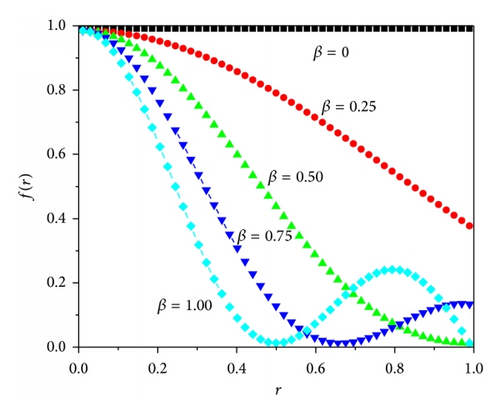
3.3. Triple Pupil Transmission
Figure 4 illustrates the response of the amplitude transmittance f(r) with the normalized radius “r” of the pupil when the aperture is shaded with the three filters, as given in expression (3). At the center of the pupil, that is, r = 0, f(r) is unity; that is, pupil transmittance is the maximum for all values of apodization parameter β and it decreases towards the edges as “r” goes from the centre to 0.50. The amplitude transmittance ceases for r = 0.5, when β = 1 and for r = 1, when β = 0.5, respectively, and at r = 0.66, f(r) attains the minimum value of 0.0001 for β = 0.75. At r = 1, f(r) = 1, 0.337, 0, 0.037, and 0 for β = 0, 0.25, 0.5, 0.75, and 1, respectively. However, for the case of extreme apodization (β = 1), f(r) varies from 1 to 0 with the damped transmittance with r.
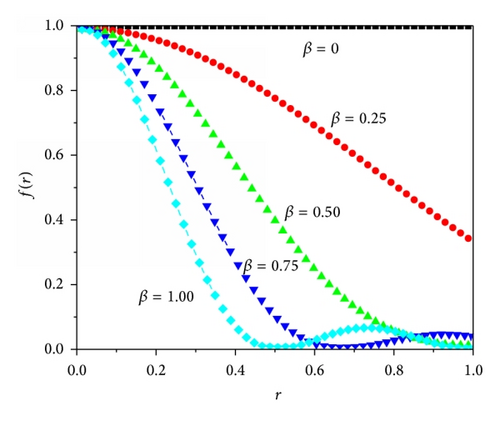
The investigations on the effects of defocus and primary spherical aberrations on the images of straight edge objects formed by coherent optical systems apodized by multiple amplitude filters in the case of circular aperture have been evaluated using the expression (5) by employing Matlab 7.8. The intensity distribution in the images of straight edge objects has been obtained for different values of dimensionless diffraction variable Z varying from −3 to 20. The image quality assessment parameter edge-ringing of the edge fringes have been studied as a function of apodization parameter “β” for single, double, and triple shaded apertures.
Figures 5, 6, and 7 give the intensity distribution curves in the case of circular aperture, apodized by shaded aperture for in-focus and defocused optical systems, respectively. The edge-ringing is the maximum in the case of clear aperture (β = 0). The edge-ringing is reducing along with edge-gradient at the cost of increasing in edge shift as the apodization parameter β is increasing from 0 to 1. However, the ringing is not completely removed with the single filter. In order to further reduce or completely remove the unwanted ringing, the multishaded aperture has been adopted.
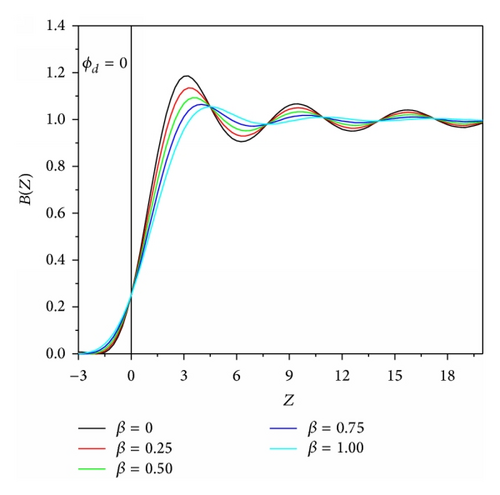
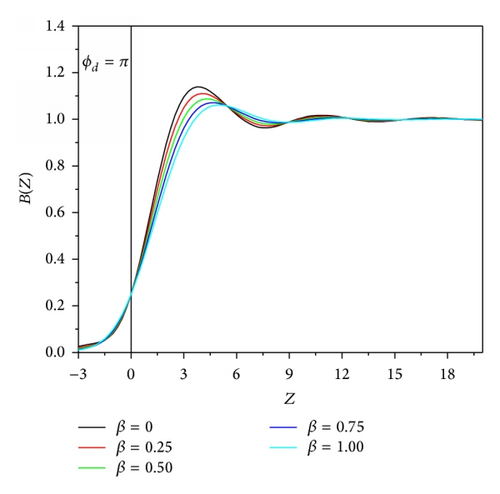
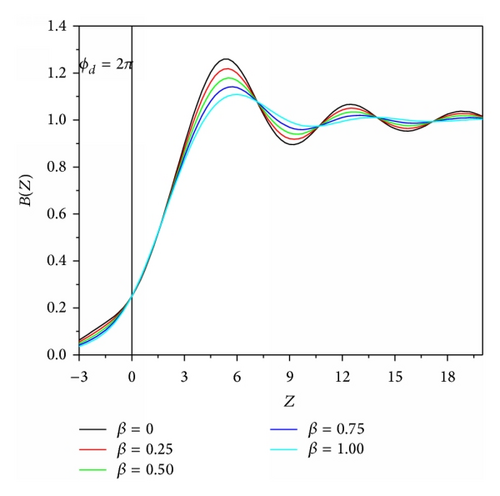
Figures 8, 9, and 10 depict the intensity distribution curves in the case of circular aperture apodized by shaded aperture and Hanning amplitude filter concurrently for focused and defocused optical systems, respectively. By this double filtering technique, the edge-ringing is reduced to lower levels as compared to that of the single filter. In similar manner, when the given aperture is shaded with the three filters at a time, the unwanted edge-ringing is reduced to a greater extent or almost removed. The intensity distribution curves for the triple filtering are shown in Figures 11, 12, and 13. This technique is almost analog to that of multistage signal filtering in the electronic-communication systems.
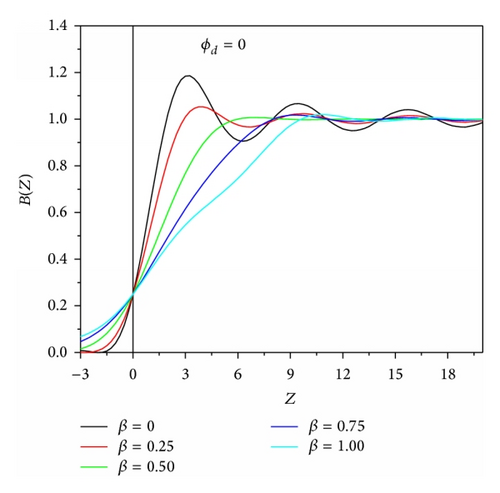
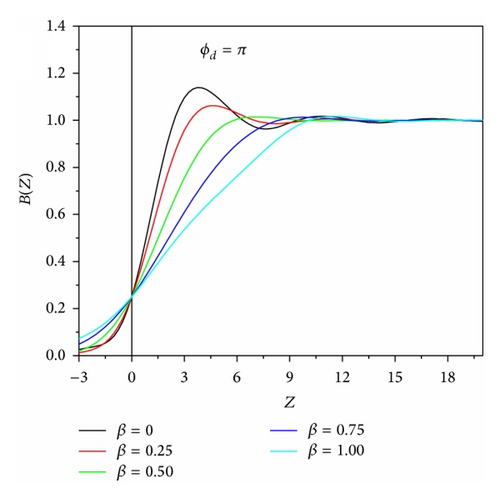
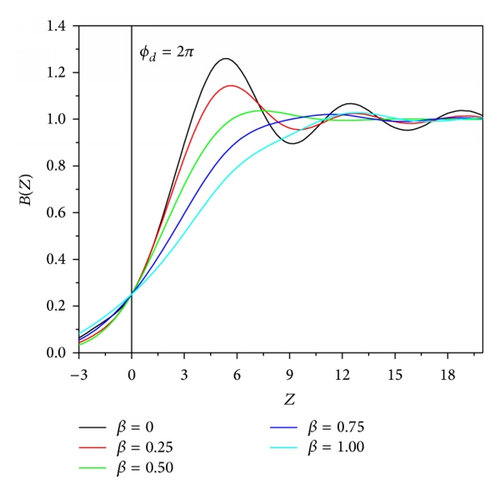
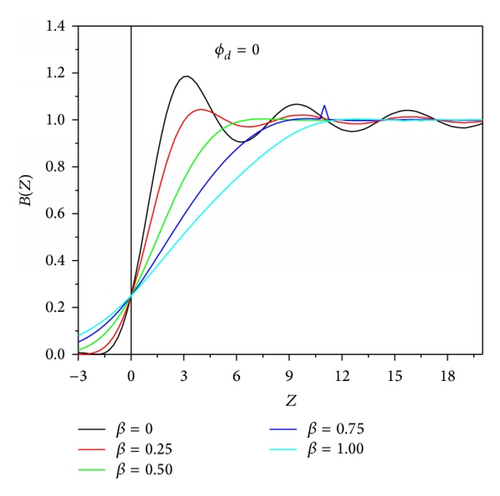
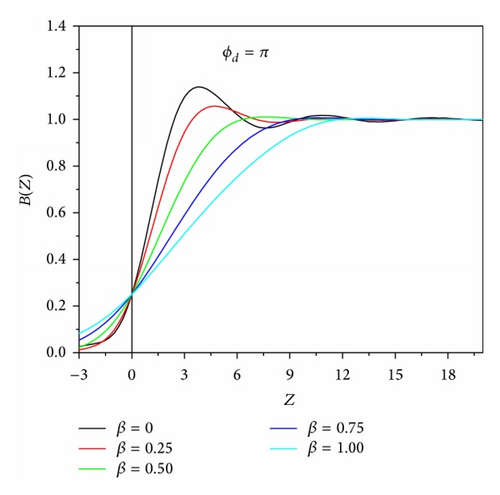
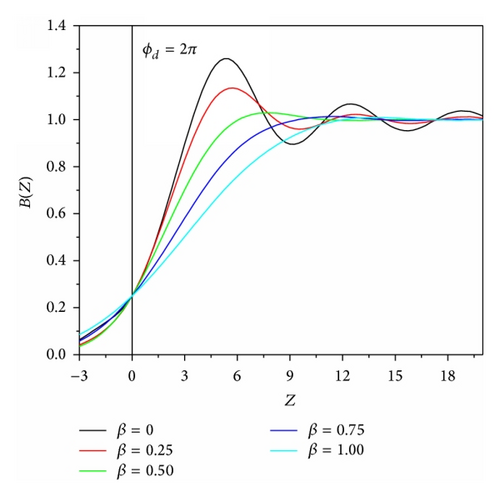
Figure 14 shows that the edge-ringing is decreasing with apodization parameter β for all values of ϕd. And it is also observed that, for a given β value, the ringing is increasing with ϕd. The edge-ringing is the maximum at ϕd = 2π for β = 0, that is, 0.2596, and it is the minimum at ϕd = 0 for β = 1, that is, 0.0548, for the single filter. When ϕd = 0, as β varies from 0 to 1, the ringing varies from 0.1857 to 0.0548. That is, the ringing is reduced by 70.5% by the apodization in the focused optical systems (as given in Figure 14(a)). It means that the edge-ringing can be minimized by the operation of apodization preferable in the absence of defocus. The edge-ringing is 0.1390 at β = 0 and attains the minimum value at β = 1, that is, 0.0615 for the single, 0.0168 for double, and 0.0048 for triple filtering. That is, the edge-ringing is reduced by 55.73%, 87.94%, and 96.56%, respectively. The combined influence of defocus and primary spherical aberration is also studied in the case of single, double, and triple shaded apertures. At the Gaussian focal plane (ϕd = 0), the edge-ringing is 0.1803 when ϕs = 2π for β = 0 (as shown in Figure 14(d)) which is less, when compared to the value of 0.1857 when ϕs = 0 for β = 0. Similarly the ringing is 0.1785 when ϕd = π and ϕs = π (Figure 14(b)) and 0.3111 when ϕd = 2π and ϕs = 2π (Figure 14(f)) for the unapodized aperture.
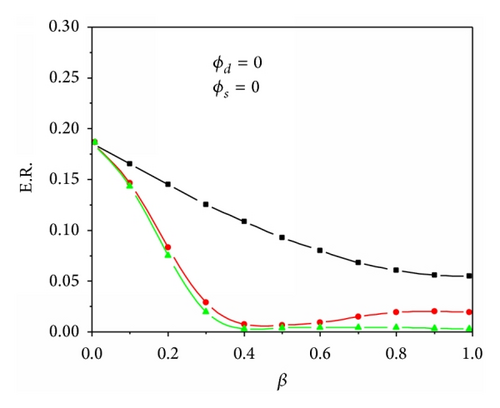
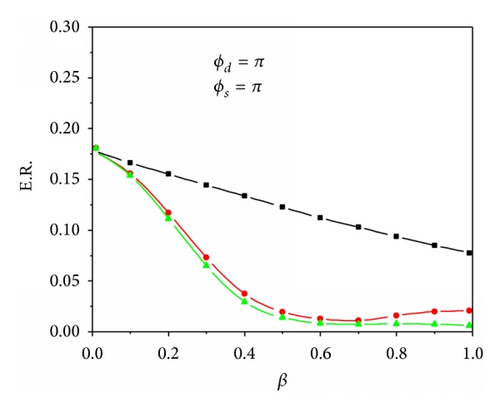
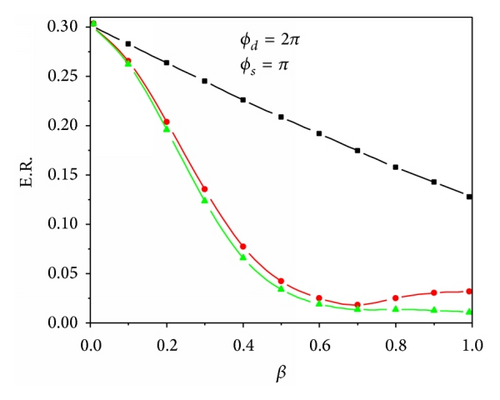
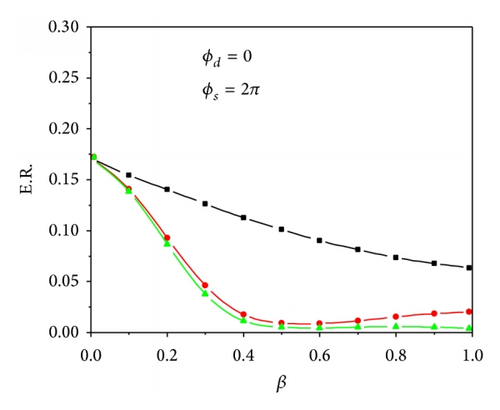
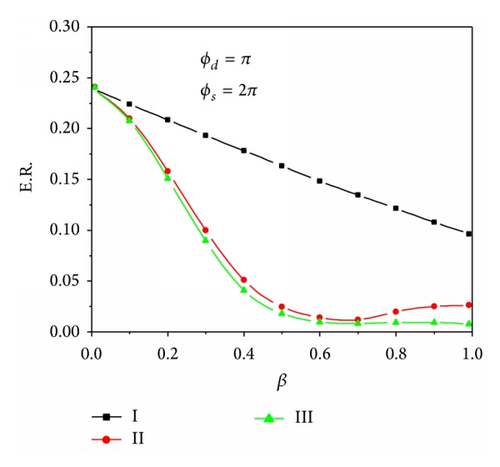
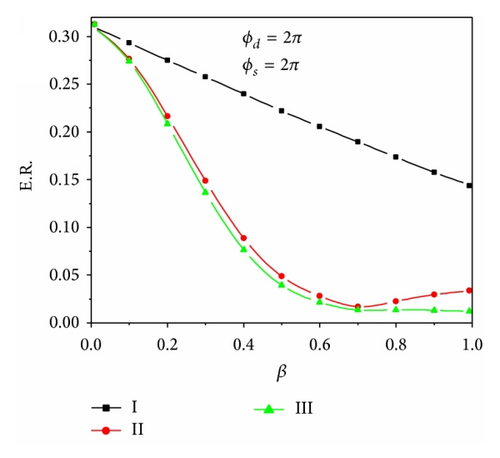
It is true that the edge-ringing is pronounced with aberrations and, however, it reduces with apodization. The edge-ringing acquired lower values for ϕd ≤ ϕs and is true for single, double, and triple shaded apertures. This shows that certain combinations of primary spherical aberration with defocus mitigate the unwanted edge-ringing even in the unapodized systems.
4. Conclusions
The important conclusions from the study carried out on the coherent edge imaging with multishaded apertures are as follows. The edge-ringing is reducing along with edge-gradient at the cost of increase in the edge shift as the apodization parameter β is increasing from 0 to 1. However, the edge-ringing is not completely removed with the single filter. In order to achieve further reduction or for the complete removal of unwanted ringing, the multishaded aperture has been adopted. By the process of double filtering the edge-ringing is reduced to lower levels as compared to single filter. In similar manner, when the coherent optical system is shaded with three filters at a time, the unwanted edge-ringing is reduced to a larger extent or almost removed. Thus, this feature of lowering or eliminating edge-ringing is at the cost of an increase in the edge shift and a further loss of edge-gradient. For the multishaded apodizer the amplitude transmittance decreases progressively from the center towards the edges of the pupil. As the pupil transmittance is decreased at the edges as compared to that of the center, due to apodization, it results in the diminution of the higher spatial frequency components in the image. Thus multishaded aperture synthesis will be a potent technique to produce highly resolved coherent imagery with fewer speckles. A multishaded aperture system has many advantages over a single-aperture system. However, it also has disadvantages, since the area of aperture is shaded with multiple filters; the effective intensity in the image may be reduced.
Conflict of Interests
The authors declare that there is no conflict of interests regarding the publication of this paper.




